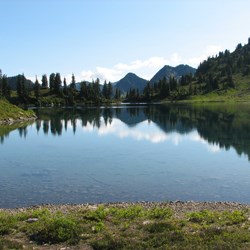Compounding effects of climate change reduce population viability of a montane amphibian
https://esajournals.onlinelibrary.wiley.com/doi/full/10.1002/eap.1832
Abstract/Summary
Anthropogenic climate change presents challenges and opportunities to the growth, reproduction, and survival of individuals throughout their life cycles. Demographic compensation among life-history stages has the potential to buffer populations from decline, but alternatively, compounding negative effects can lead to accelerated population decline and extinction. In montane ecosystems of the US Pacific Northwest, increasing temperatures are resulting in a transition from snow-dominated to rain-dominated precipitation events, reducing snowpack. For ectotherms such as amphibians, warmer winters can reduce the frequency of critical minimum temperatures and increase the length of summer growing seasons, benefiting post-metamorphic stages, but may also increase metabolic costs during winter months, which could decrease survival. Lower snowpack levels also result in wetlands that dry sooner or more frequently in the summer, increasing larval desiccation risk. To evaluate how these challenges and opportunities compound within a species? life history, we collected demographic data on Cascades frog (Rana cascadae) in Olympic National Park in Washington state to parameterize stage-based stochastic matrix population models under current and future (A1B, 2040s and 2080s) environmental conditions. We estimated the proportion of reproductive effort lost each year due to drying using watershed-specific hydrologic models, and coupled this with an analysis that relates 15-years of R. cascadae abundance data with a suite of climate variables. We estimated the current population growth (λs) to be https://0.98 (95% CI: 0.97-0.99), but predict that λs will decline under continued climate warming, resulting in a 62% chance of extinction by the 2080s because of compounding negative effects on early and late life history stages. By the 2080s, our models predict that larval mortality will increase by 17% as a result of increased pond drying, and adult survival will decrease by 7% as winter length and summer precipitation continue to decrease. We find that reduced larval survival drives initial declines in the 2040s, but further declines in the 2080s are compounded by decreases in adult survival. Our results demonstrate the need to understand the potential for compounding or compensatory effects within different life history stages to exacerbate or buffer the effects of climate change on population growth rates through time.
Publication details
| Published Date: | 2018-12-27 |
| Outlet/Publisher: | Ecological Applications |
| Media Format: |
ARMI Organizational Units:
Pacific Northwest - BiologyTopics:
DroughtMonitoring and Population Ecology
Place Names:
WashingtonKeywords:
climatehydroperiod

